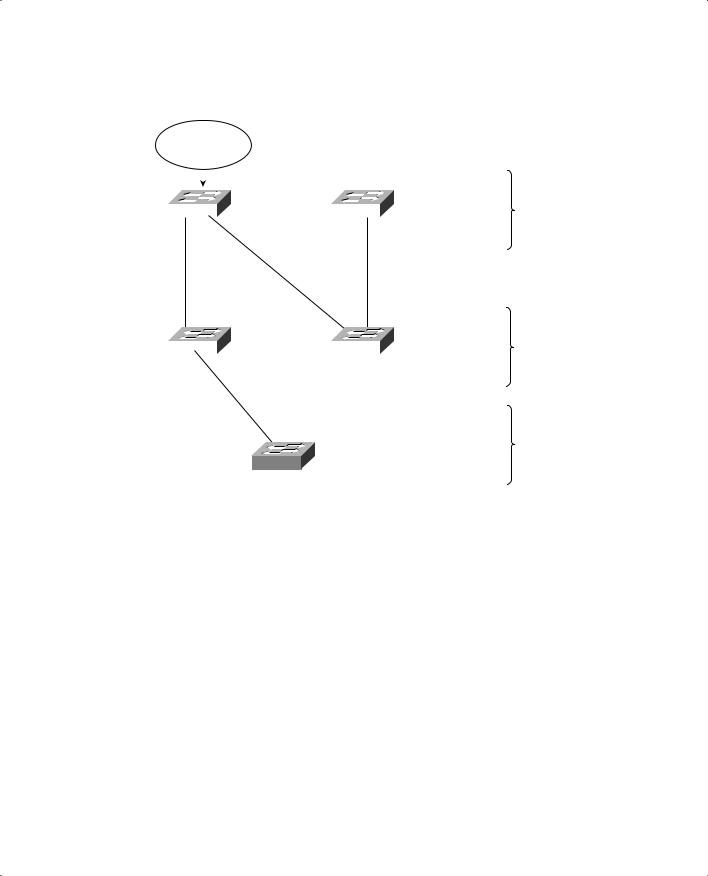
CCNP 642-811 BCMSN Exam Certification Guide - Cisco press
.pdf
246 Chapter 10: Spannning Tree Configuration
Figure 10-3 Final Spanning Tree Structure for the Campus Network
Root Bridge
Catalyst A |
|
|
|
|
Catalyst B |
|
|
|
|
||||
32768 |
|
|
|
|
32768 |
|
00-00-00-00-00-0a |
|
|
|
|
|
00-00-00-00-00-0b |
|
|
|
|
|
||
100Mbps |
100Mbps |
1Gbps |
||||
Catalyst C |
|
|
|
Catalyst D |
32768 |
|
|
|
32768 |
|
|
|||
00-00-00-00-00-0c |
|
|
|
00-00-00-00-00-0d |
|
|
1Gbps
Catalyst E
32768 00-00-00-00-00-0e
Access Layer
Core Layer
Server Farm
Catalyst A, an access layer switch, is the Root Bridge. Workstations on Catalyst A can reach servers on Catalyst E by crossing through the core layer (Catalyst C), as expected. However, notice what has happened to the other access layer switch, Catalyst B. Workstations on this switch must cross into the core layer (Catalyst D), back into the access layer (Catalyst A), back through the core (Catalyst C), and finally to the server farm (Catalyst E). This action is obviously inefficient. For one, Catalyst A is probably not a high-end switch because it is used in the access layer. However, the biggest issue is that other access layer areas are forced to thread through the relatively slow uplinks on Catalyst A. This winding path will become a major bottleneck to the users.
Root Bridge Configuration
To prevent the surprises outlined in the previous section, you should always do two things:
■Configure one switch as a Root Bridge in a determined fashion.
■Configure another switch as a secondary Root Bridge in case of primary Root Bridge failure.

STP Root Bridge 247
As the common reference point, the Root Bridge (and the secondary) should be placed near the center of the Layer 2 network. For example, a switch in the distribution layer would make a better Root Bridge choice than one in the access layer because more traffic is expected to pass through the distribution layer devices. In a flat switched network (no Layer 3 devices), a switch near a server farm would be a more efficient Root Bridge than switches elsewhere. Most traffic will be destined to and from the server farm and will benefit from a predetermined, direct path.
To configure a Catalyst switch to become the Root Bridge, use one of the following methods:
■Directly modify the Bridge Priority value so that a switch can be given a lower-than-default Bridge ID value to win a Root Bridge election:
Switch (config)# spanning-tree vlan vlan-id priority bridge-priority
The bridge-priority value defaults to 32,768, but you can also assign a value of 0 to 65,535. Remember that Catalyst switches run one instance of STP for each VLAN (PVST+), so the VLAN ID must always be given. You should designate an appropriate Root Bridge for each VLAN.
■Let the switch become the Root by automatically choosing a Bridge Priority value:
Switch(config)# spanning-tree vlan vlan-id root {primary | secondary} [diameter diameter]
This command is actually a macro on the Catalyst that executes several other commands. The result is a more direct and automatic way to force one switch to become the Root Bridge. Actual Bridge Priorities are not given in the command. Rather, the switch modifies STP values according to the current values in use within the active network. These values are modified only once, when the macro command is issued.
Use the primary keyword to make the switch attempt to become the primary Root Bridge. This command modifies the switch’s Bridge Priority value to become less than the Bridge Priority of the current Root Bridge. If the current Root Priority is more than 24,576, the local switch sets its priority to 24,576. If the current Root Priority is less than that, the local switch sets its priority to 4096 less than the current Root.
For the secondary Root Bridge, the Root Priority is set to 28,672. There is no way to query or listen to the network to find another potential secondary Root, so this priority is used under the assumption that it is less than the default priorities (32,768) that might be used elsewhere.
You can also modify the network diameter with this command, if needed. This modification is discussed further in the “Tuning Spanning Tree Convergence” section later in the chapter.

248 Chapter 10: Spannning Tree Configuration
NOTE The spanning-tree vlan vlan-id root command will not be shown in a Catalyst switch configuration because the command is actually a macro executing other switch commands. The actual commands and values produced by the macro will be shown, however. For example, the macro can potentially adjust the four STP values as follows:
Switch(config)#spanning-tree vlan 1 |
root primary |
||||
vlan 1 |
bridge priority set to 24576 |
|
|||
vlan 1 |
bridge max aging time unchanged at 20 |
||||
vlan |
1 |
bridge |
hello time unchanged |
at |
2 |
vlan |
1 |
bridge |
forward delay unchanged |
at 15 |
|
Be aware that this macro doesn’t guarantee that the switch will become the Root and maintain that status. It is entirely possible for the Bridge Priority to be configured to a lower value on another switch in the network, displacing the switch that ran the macro.
On the Root, it is usually good practice to directly modify the Bridge Priority to an artificially low value (even priority 1 or 0!) with the spanning-tree vlan vlan-id priority bridge-priority command. This will make it more difficult for another switch in the network to win the Root Bridge election.
Spanning Tree Customization
The most important decision you can make when designing your Spanning Tree topology is the placement of the Root Bridge. Other decisions, such as the exact loop-free path structure, will occur automatically as a result of the Spanning Tree Algorithm (STA). Occasionally, the path might need additional tuning, but only under special circumstances and after careful consideration.
Recall the sequence of four criteria that STP uses to choose a path:
1.Lowest Bridge ID
2.Lowest Root Path Cost
3.Lowest Sender Bridge ID
4.Lowest Sender Port ID
The previous section discussed how to tune a switch’s Bridge ID to place the Root Bridge in a network. You can use this technique to force a switch to have the lowest Bridge ID and also to influence the sending Bridge ID of other switches (lowest Bridge ID and lowest Sender Bridge ID). However, only the automatic STP computation has been discussed, using the default switch port costs to make specific path decisions.
Tuning the Root Path Cost
The Root Path Cost for each active port of a switch is determined by the cumulative cost as a BPDU travels along. As a switch receives a BPDU, the port cost of the receiving port is added to the Root

STP Root Bridge 249
Path Cost in the BPDU. The port or path cost is inversely proportional to the port’s bandwidth. If desired, a port’s cost can be modified from the default value.
NOTE Before modifying a switch port’s path cost, you should always calculate the Root Path costs of other alternate paths through the network. Changing one port’s cost might influence STP to choose that port as a Root Port, but other paths could still be preferred. You should also calculate a port’s existing path cost to determine what the new cost value should be. Careful calculation will ensure that the desired path will indeed be chosen.
Use the following interface configuration command to set a switch port’s path cost:
Switch (config-if)# spanning-tree [vlan vlan-id] cost cost
If the vlan parameter is given, the port cost is modified only for the specified VLAN. Otherwise, the cost is modified for the port as a whole (all active VLANs). Table 10-2 lists the cost value ranges from 1 to 65,535, according to the standard IEEE values.
Table 10-2 STP Path Cost
Link Bandwidth |
STP Cost |
|
|
4 Mbps |
250 |
|
|
10 Mbps |
100 |
|
|
16 Mbps |
62 |
|
|
45 Mbps |
39 |
|
|
100 Mbps |
19 |
|
|
155 Mbps |
14 |
|
|
622 Mbps |
6 |
|
|
1 Gbps |
4 |
|
|
10 Gbps |
2 |
|
|
Tuning the Port ID
The fourth criteria of an STP decision is the Port ID. The Port ID value that a switch uses is actually a 16-bit quantity—8 bits for the Port Priority and 8 bits for the Port Number. Port Priority is a value from 0 to 255 and defaults to 128 for all ports. The Port Number can range from 0 to 255 and represents the port’s actual physical mapping. Port Numbers begin with 1 at port 0/1 and increment across each module. (The numbers might not be consecutive because each module is assigned a particular range of numbers.)

250 Chapter 10: Spannning Tree Configuration
Obviously, switch port’s Port Number is fixed because it is based on hardware location. The Port ID, however, can be modified to influence an STP decision by using the Port Priority. You can configure the Port Priority with this interface configuration command:
Switch(config-if)# spanning-tree [vlan vlan-list] port-priority port-priority
You can modify the Port Priority for a specific VLAN by using the vlan parameter. Otherwise, the Port Priority is set for the port as a whole (all active VLANs). The value of port-priority can range from 0 to 255 and defaults to 128.
Tuning Spanning Tree Convergence
STP uses several timers, a sequence of states that ports must move through, and specific topology change conditions to prevent bridging loops from forming in a complex network. Each of these parameters or requirements is based on certain default values for a typical network size and function. For the majority of cases, the default STP operation is sufficient to keep the network loop free and enable users to communicate.
However, in certain situations,the default STP can cause network access to be delayed while timers expire and while preventing loops on links where loops are not possible. For example, when a single PC is connected to a switch port, a bridging loop is simply not possible. Another situation relates to the size of a Layer 2 switched network—the default STP timers are based on a benchmark network size. In a network that is smaller, waiting until the default timer values expire might not make sense when they could be safely set to shorter values. In situations like this, you can safely make adjustments to the STP convergence process for more efficiency.
Modifying STP Timers
Recall that STP uses three timers to keep track of various port operation states and communication between bridges. The three STP timers can be adjusted by using the commands documented in the sections that follow. Remember that the timers need only be modified on the Root Bridge because the Root Bridge propagates all three timer values throughout the network as fields in the Configuration BPDU.
Use one or more of the following global configuration commands to modify STP timers:
Switch(config)# spanning-tree [vlan vlan-id] Switch(config)# spanning-tree [vlan vlan-id] Switch(config)# spanning-tree [vlan vlan-id]
hello-time seconds forward-time seconds max-age seconds

Tuning Spanning Tree Convergence 251
The Hello Timer triggers periodic “hello” (actually the Configuration BPDU) messages that are sent from the Root to other bridges in the network. This timer also sets the interval in which a bridge expects to hear a hello relayed from its neighboring bridges. Configuration BPDUs are sent every 2 seconds, by default. You can modify the Hello Timer per VLAN with the hello-time keyword, along with a value of 1 to 10 seconds.
The Forward Delay Timer determines the amount of time a port stays in the Listening state before moving into the Learning state and how long it stays in the Learning state before moving to the Forwarding state. You can modify the Forward Delay Timer per VLAN with the forward-time keyword. The default value is 15 seconds but can be set to a value of 4 to 30 seconds. This timer should be modified only under careful consideration because the value is dependent upon the diameter of the network and the propagation of BPDUs across all switches. A value too low allows loops to form and cripples a network.
The MaxAge Timer specifies a stored BPDU’s lifetime that has been received from a neighboring switch with a Designated Port. Suppose BPDUs are being received on a non-Designated switch port every 2 seconds, as expected. Then an indirect failure, or one that doesn’t involve a physical link going down, occurs that prevents BPDUs from being sent. The receiving switch waits until the Max Age Timer expires to listen for further BPDUs. If none are received, the non-Designated Port moves into the Listening state, and the receiving switch generates Configuration BPDUs. This port then becomes the Designated Port to restore connectivity on the segment.
To modify the Max Age Timer on a per-VLAN basis, use the max-age keyword. The timer value defaults to 20 seconds but can be set from 6 to 40 seconds.
NOTE Modifying STP timers can be tricky given the conservative nature of the default values and the calculations needed to derive proper STP operation. Timer values are basically dependent on the Hello Time and the switched network’s diameter, in terms of switch hops. Catalyst switches offer a single command that can change the timer values in a more controlled fashion. Although described earlier, the spanning-tree vlan vlan-id root macro command is a better tool to use than setting the timers with the individual commands. This global configuration command has the following syntax:
Switch(config)# spanning-tree vlan vlan-id root {primary | secondary} [diameter diameter [hello hello-time]]
Here, STP timers will be adjusted according to the formulas specified in the 802.1D standard by giving only the Hello Time and the network’s diameter (the maximum number of switches that traffic will traverse across a Layer 2 network). Again, this command can be used on a per-VLAN basis to modify the timers for a particular VLAN’s spanning tree. The network diameter can be a value from one to seven switch hops. Because this command makes a switch become the Root Bridge, all the modified timer values resulting from this command will be propagated to other switches through the Configuration BPDU.

252 Chapter 10: Spannning Tree Configuration
Redundant Link Convergence
Some additional methods that exist to allow faster STP convergence in the event of a link failure include the following:
■PortFast—Enables fast connectivity to be established on access layer switch ports to workstations that are booting up
■UplinkFast—Enables fast uplink failover on an access layer switch when dual uplinks are connected into the distribution layer
■BackboneFast—Enables fast convergence in the network backbone (core) after a Spanning Tree topology change occurs
Rather than modifying timer values, these methods work by controlling convergence on specifically located ports within the network hierarchy.
NOTE The Spanning Tree Protocol has been enhanced to allow almost instantaneous topology changes, rather than rely on these Cisco-proprietary extensions. This enhancement is known as the Rapid Spanning Tree Protocol, or IEEE 802.1w, and is covered in Chapter 12, “Advanced Spanning Tree Protocol.” You should become familiar with the topics in this chapter first because they provide the basis for the concepts in Chapter 12.
PortFast: Access Layer Nodes
An end-user workstation is usually connected to a switch port in the access layer. If the workstation is powered off and then turned on, the switch port will not be in a usable state until STP cycles from the Blocking state to the Forwarding state. With the default STP timers, this transition takes at least 30 seconds (15 seconds Listening to Learning and 15 seconds Learning to Fowarding). Therefore, the workstation is unable to transmit or receive any useful data until the Forwarding state is reached on the port.
NOTE Port initialization delays of up to 50 seconds can be observed. As discussed, 30 of these seconds are due to the STP state transitions. If a switch port is running Port Aggregation Protocol (PAgP) to negotiate EtherChannel configuration, an additional 20-second delay can occur.
On switch ports that connect only to single workstations or specific devices, bridging loops should never be possible. Catalyst switches offer the PortFast feature that shortens the Listening and Learning states to a negligible amount of time. When a workstation link comes up, the switch immediately moves the PortFast port into the Forwarding state. Spanning tree loop detection is still in operation, however, and the port moves into the Blocking state if a loop is ever detected on the port.

Redundant Link Convergence 253
To enable or disable the PortFast feature on a switch port, use the following interface configuration command:
Switch(config-if)# spanning-tree portfast
Obviously, you should not enable PortFast on a switch port that is connected to a hub or another switch because bridging loops could possibly form. One other benefit of PortFast is that topology change notification (TCN) BPDUs are not sent when a switch port in PortFast mode goes up or down. This simplifies the TCN transmission on a large network when end-user workstations are coming up or shutting down.
UplinkFast: Access Layer Uplinks
Consider an access layer switch that has redundant uplink connections to two distribution layer switches. Normally, one uplink would be in the Forwarding state and the other in the Blocking state. If the primary uplink went down, up to 50 seconds could elapse before the redundant uplink could be used.
The UplinkFast feature on Catalyst switches enables leaf-node switches or switches at the ends of the spanning tree branches to have a functioning Root Port while keeping one or more redundant or potential Root Ports in Blocking mode. When the primary Root Port uplink fails, another blocked uplink can be immediately brought up for use.
NOTE Many Catalyst switches have two built-in, high-speed uplink ports (Gigabit Ethernet, for example). You might get the idea that UplinkFast can only toggle between two leaf-node uplink ports. This is entirely untrue—UplinkFast keeps a record of all parallel paths to the Root Bridge. All uplink ports but one are kept in the Blocking state. If the Root Port fails, the uplink with the next-lowest Root Path Cost is unblocked and used.
To enable the UplinkFast feature, use the following global configuration command:
Switch(config)# spanning-tree uplinkfast [max-update-rate pkts-per-second]
When UplinkFast is enabled, it is enabled for the entire switch and all VLANs. UplinkFast works by keeping track of possible paths to the Root Bridge. Therefore, the command is not allowed on the Root Bridge switch. UplinkFast also makes some modifications to the local switch to ensure that it does not become the Root Bridge, and that the switch is not used as a transit switch to get to the Root Bridge. First, the switch’s Bridge Priority is raised to 49,152, making it unlikely that the switch will be elected to Root Bridge status. The Port Cost of all local switch ports is incremented by 3000, making the ports undesirable as paths to the Root for any downstream switches.

254 Chapter 10: Spannning Tree Configuration
The command also includes a max-update-rate parameter. When an uplink on a switch goes down, UplinkFast makes it easy for the local switch to update its bridging table of MAC addresses to point to the new uplink. However, UplinkFast also provides a mechanism for the local switch to notify other upstream switches that stations downstream (or on toward the access layer) can be reached over the newly activated uplink.
This action is accomplished by sending dummy multicast frames to destination 0100.0ccd.cdcd that contain the MAC addresses of the stations in the Content-Addressable Memory (CAM) table. These multicast frames are sent out at a rate specified by the max-update-rate parameter in packets per second. The default is 150 packets per second (pps), but the rate can range from 0 to 65,535 pps. If the value is 0, no dummy multicasts are sent.
BackboneFast: Redundant Backbone Paths
In the network backbone, or core layer, a different method is used to shorten STP convergence. BackboneFast works by having a switch actively determine if alternate paths exist to the Root Bridge in the event that the switch detects an indirect link failure. Indirect link failures occur when a link not directly connected to a switch fails. A switch detects an indirect link failure when it receives inferior BPDUs from its Designated Bridge on either its Root Port or a Blocked Port. (Inferior BPDUs are sent from a Designated Bridge that has lost its connection to the Root Bridge, making it announce itself as the new Root.)
Normally, a switch must wait for the Max Age timer to expire before responding to the inferior BPDUs. However, BackboneFast begins to determine if other alternate paths to the Root Bridge exist according to the type of port that received the inferior BPDU. If the inferior BPDU arrives on a port in the Blocking state, the switch considers the Root Port and all other blocked ports to be alternate paths to the Root Bridge. If the inferior BPDU arrives on the Root Port itself, the switch considers all blocked ports to be alternate paths to the Root Bridge. If the inferior BPDU arrives on the Root Port and no ports are blocked, however, the switch assumes it has lost connectivity with the Root Bridge. In this case, the switch assumes that it has become the Root Bridge and, BackboneFast allows it to do so before the Max Age timer expires.
Detecting alternate paths to the Root Bridge also involves an interactive process with other bridges. If the local switch has blocked ports, BackboneFast begins to use the Root Link Query (RLQ) protocol to see if upstream switches have stable connections to the Root Bridge. RLQ Requests are sent out. If a switch receives an RLQ Request and is either the Root Bridge or has lost connection to the

Troubleshooting STP 255
Root, it sends an RLQ Reply. Otherwise, the RLQ Request is propagated on to other switches until an RLQ Reply can be generated. On the local switch, if an RLQ Reply is received on its current Root Port, the path to the Root Bridge is intact and stable. If it is received on a non-Root Port, an alternate Root Path must be chosen. The Max Age Timer is immediately expired so that a new Root Port can be found.
BackboneFast is simple to configure and operates by short-circuiting the Max Age Timer when needed. Although this function shortens the time a switch waits to detect a Root Path failure, ports still must go through full-length Forward Delay Timer intervals during the Listening and Learning states. Where PortFast and UplinkFast enable immediate transitions, BackboneFast can only reduce the maximum convergence delay from 50 to 30 seconds.
To configure BackboneFast, use the following global configuration command:
Switch(config)# spanning-tree backbonefast
When used, BackboneFast should be enabled on all switches in the network because BackboneFast requires the use of the RLQ Request and Reply mechanism to inform switches of Root Path stability. The RLQ protocol is active only when BackboneFast is enabled on a switch. By default, BackboneFast is disabled.
Troubleshooting STP
Because the STP running in a network uses several timers, costs, and dynamic calculations, predicting the current state in your head is difficult. You can take a network diagram and work out the STP topology by hand, but any change on the network could produce an entirely different outcome. Then figure in something like PVST+, where you have one instance of STP running for each VLAN present. Obviously, simply viewing the STP status on the active network devices would be better.
You can display information about many aspects of the STP from a Catalyst switch command-line interface (CLI). Specifically, you need to find out the current Root Bridge and its location in the network. You might also want to see the Bridge ID of the switch where you are connected, to see how it participates in STP. Use the information in Table 10-2 to determine what command is useful for what situation.
